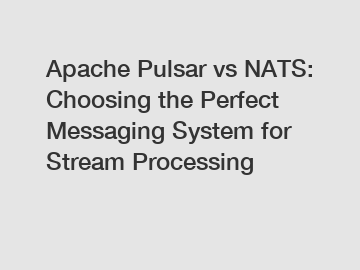Apache Pulsar vs NATS: Choosing the Perfect Messaging System for Stream Processing
Apache Pulsar vs NATS: Choosing the Perfect Messaging System for Stream Processing?
Apache Pulsar and NATS are both popular messaging systems used for stream processing. They offer unique features and capabilities that make them ideal for different use cases. Understanding the differences between the two is crucial for making an informed decision on which system to choose. In this article, we will compare Apache Pulsar and NATS, discussing their strengths and weaknesses, and exploring when to use each system.
1. Scalability and Performance:

Apache Pulsar is known for its exceptional scalability and performance. It is built on a distributed architecture that allows for horizontal scaling, meaning it can handle increasing data loads without sacrificing efficiency. With Pulsar's layered architecture, it can support millions of topics and thousands of partitions, making it a robust choice for applications that deal with high data throughput.
On the other hand, NATS is designed to be extremely lightweight and efficient. While it may not scale as seamlessly as Pulsar, NATS boasts blistering fast latency and throughput. This makes it an excellent choice for use cases that prioritize minimal latency and real-time processing.
2. Fault Tolerance and Reliability:
When it comes to fault tolerance and reliability, Apache Pulsar shines. Pulsar ensures message durability using the concept of bookkeeper ensemble, which replicates messages across multiple nodes in a cluster. This replication mechanism guarantees that messages are not lost even in the event of node failures, ensuring reliable message delivery.
NATS, on the other hand, focuses on simplicity and speed rather than advanced fault tolerance mechanisms. While it does offer some failover and clustering capabilities, it may not be as resilient as Pulsar in scenarios where data loss is unacceptable.
3. Ecosystem and Integration:
Apache Pulsar has a rich ecosystem and enjoys deep integration with popular big data and stream processing frameworks like Apache Flink, Apache Spark, and Kafka. Its broad range of connectors makes it easier to integrate with various data sources and sinks. Pulsar also provides a RESTful API, client libraries in different programming languages, and a user-friendly management UI.
NATS, on the other hand, is designed to be lightweight and minimalistic, offering a less extensive integration ecosystem compared to Pulsar. However, it still offers support for popular programming languages like Go, Java, Python, and more, making it flexible enough for many use cases.
4. Community and Support:
Both Apache Pulsar and NATS have active and growing communities. Pulsar benefits from being an Apache Software Foundation project, meaning it has a large user base and robust community support. This ensures regular updates, bug fixes, and improvements. Additionally, the Apache Pulsar community provides comprehensive documentation, tutorials, and support channels.
NATS may have a slightly smaller community compared to Pulsar, but it is backed by Synadia and has dedicated support options available. The NATS community is known for being responsive and helpful, providing assistance to users when needed.
Based on these points, it is evident that choosing between Apache Pulsar and NATS depends on your specific requirements. If you need massive scalability, fault tolerance, and an extensive integration ecosystem, Apache Pulsar is the optimal choice. However, if your focus is on low latency, lightweight operation, and simplicity, NATS may be the better option.
In conclusion, both Apache Pulsar and NATS are powerful messaging systems suitable for stream processing tasks. Understanding their strengths and weaknesses is essential to select the perfect system for your specific use case. Whether it's the scalable and reliable Pulsar or the lightweight and high-performance NATS, both systems provide valuable tools in the world of stream processing. The key is to match your requirements with the strengths of each system to make an informed decision on which one will best suit your needs.
If you are looking for more details, kindly visit What is Message Queue, Event Stream Connectors, Event Streaming Platform Vs Message Queue.

Comments
0